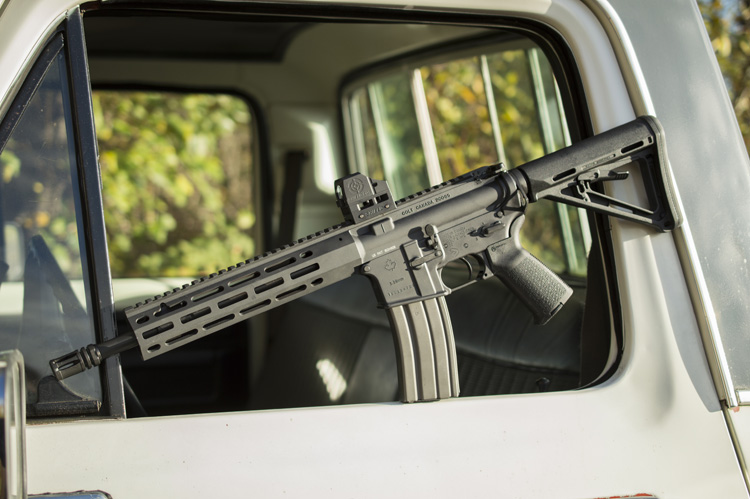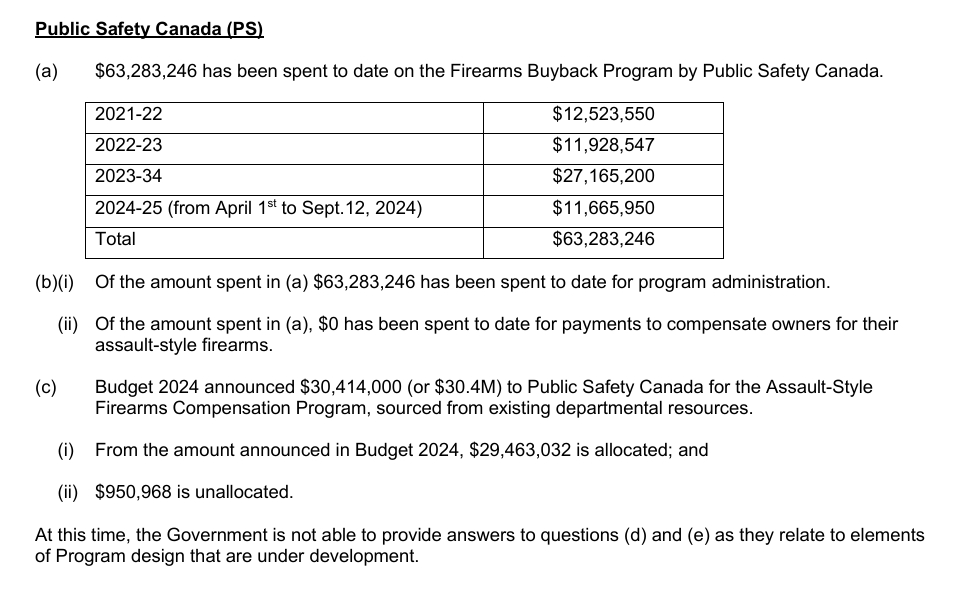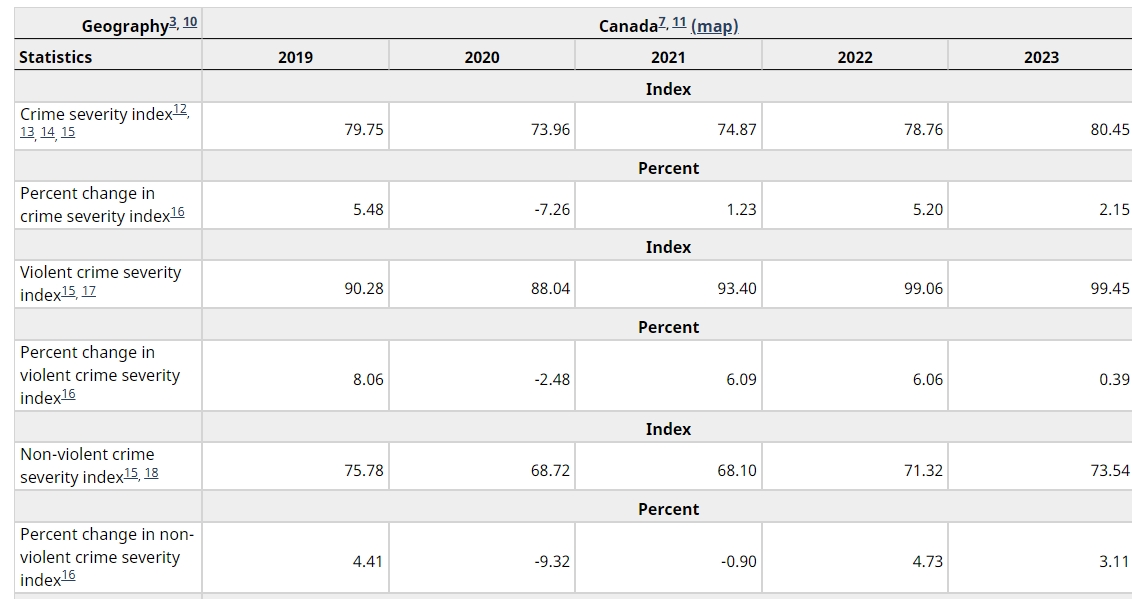
The amount of money allocated by Public Safety for the Liberals’ long gun ban announced four years ago has increased again, according to Public Safety’s most recent financial report, and means the combined total spent by Public Safety and the RCMP on the ban since its inception will eclipse $100M this fiscal year. It has not yet confiscated a single firearm.
Having originally been provided with $30.4M over two years by Budget 2024 “for the buyback of assault-style firearms,” Public Safety’s most recent Quarterly Financial Report for the period ending June 30th indicates that the department is now earmarking $36.9M for the program this fiscal year: $23.2M in operating expenses for the Assault Style Firearms Compensation Program (ASFCP), and $13.7M for new funding delivered through grants and contributions “to complete the collection and destruction of business owned assault style firearms and to establish a compensation program.”

Additionally, Budget 2024’s allocation of $30.4M stated that funding would be “sourced from existing departmental resources,” however, the financial report identifies the $23.2M in operating expenses incurred by the Assault Style Firearms Compensation Program (ASFCP) as the largest contributor to a 21.9% increase in Public Safety’s operating costs year-over-year, with the ASFCP now constituting 9.6% of Public Safety’s annual operating budget. Additionally, the $13.7M provided for grants and contributions to action Phase 1 of the gun ban is explicitly referred to as “new funding.”
A recent Order Paper question tabled by Ontario MP Larry Brock revealed that Public Safety had spent $51.6M on the ban from 2021 to 2023, which brings their total projected spending on the ban to at least $88.5M by the time the government’s fiscal year ends next March. However, that total may grow again, if Public Safety felt the need to increase the program’s funding after the period reflected by the quarterly report. It also does not include the amount spent by Public Safety during the 11-month period between the ban’s introduction on May 1, 2020 and the following April 1st, 2021. But for context, Public Safety reports having spent $12.5M and $12M on the ban in the 2021 and 2022 fiscal years, respectively.

Additionally, that same Order Paper question revealed that the RCMP have spent $13.4M on the ban thus far, meaning the combined known cost of the ban will surpass $100M sometime between now and next March, when it is projected to reach $101.9M - and it’s entirely possible that figure will be surpassed, or perhaps already has been, given the full scope of the RCMP’s financial commitment to the ban for 2024/2025 is not known, and Public Safety’s inability to report on what introducing the ban cost.
Public Safety’s 2024/2025 Departmental Plan laid out the ministry’s intent to “continue work towards the launch of the Firearms Compensation Program (FCP) for businesses,” eventually indicating that it hoped to begin the confiscation of firearms from businesses in the Fall of 2024. Questioned about this in a press conference on September 25th, Minister of Public Safety Dominic Leblanc claimed the program was “on track,” and that the confiscation of firearms from businesses would begin no later than November 8. To this end, on October 16th, the government introduced an order-in-council allowing Canada Post to handle and store these prohibited firearms deemed too dangerous for even firearms businesses to retain, but as of now, the confiscation / compensation program remains unintroduced and unavailable to both business owners and individuals.
Moreover, with the government’s chosen shipping company for the business portion of the confiscation being served a strike notice by their unionized labour force, even if introduced, this first phase of the so-called “buyback” may stall if postal workers walk off the job later this month.
Finally, the confiscation of firearms from individuals was entirely omitted from the 2024/2025 departmental plan, meaning the much larger and more complicated task of seizing firearms from licensed gun owners and issuing compensation was never projected to begin before the end of this fiscal year. It is expected to come after the confiscation of firearms from businesses begins, but due to obvious logistical issues (Canada Post, for example, has refused to handle firearms being confiscated from individuals, citing concerns over staff safety), will likely look almost entirely different from the portion of the program targeting businesses. Lastly, anyone possessing these firearms is protected from being criminally charged for owning them until October 30th, 2025 - just days after the next fixed election date.
Over the same span of time as all this has occurred, Public Safety has not just been failing to achieve its own goals with regard to crime prevention and community safety, it’s been falling further behind in some of the most important metrics year-over-year. According to Public Safety’s own reporting, the Crime Severity Index has risen from 73.96 in 2021, to 74.9 in 2022, before jumping considerably to 78.1 in 2023 - getting farther and farther from Public Safety’s goal of 70.1. The crime rate, similarly, has gone from 5,301 to 5,375 to 5,625 - again, farther from the department’s stated goal of getting the crime rate below 5,200. The only metric by which Public Safety is actually achieving its goal in the name of “Canadian communities are safe” is the percent of homicides categorized as firearm-related, where 2023’s result of 39.2% satisfies Public Safety’s goal of maintaining a rate less than 40%. However, it’s going in the wrong direction: 36.6% of homicides were gun-related in 2021 and 37.7% in 2022.

More mystifying is that while Public Safety states that Statistics Canada provides these indicators, none of the figures reported by Public Safety match those available from Statistics Canada, and generally seem to understate the reality. According to Statistics Canada, the Crime Severity Index was 74.87 in 2021, 78.76 in 2022, and 80.45 in 2023. Likewise, the crime rates reported directly by Statistics Canada are dramatically higher; 5,921 in 2021, 6,229 in 2022, and 6,302 in 2023. The percentage of homicides committed by shooting seems entirely disconnected from Public Safety’s reporting, at 37.3, 38.8, and 37.1. These discrepancies perhaps give some insight as to why Public Safety also reports a reduction in the “percentage of stakeholders who report consulting Public Safety research or policy documents to inform their decision making” from 91% in 2021 to 70% in 2023.

In 2019, an unredacted report from the Department of Justice indicated that an “assault-style firearms buyback” would likely cost $1.8 billion dollars between administration and compensation. Today, that would equate to $2.1 billion, which is still lower than the $4-6 billion estimated by some - and all are dramatically more than the premature and overly simplistic $300-400 million figure put forth by Bill Blair; a figure that now looks comically low, given the program is poised to have consumed $100 million without seizing a single firearm.